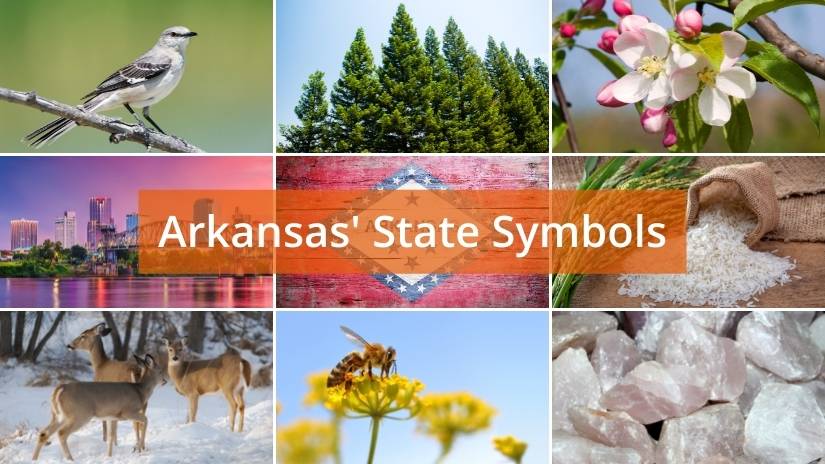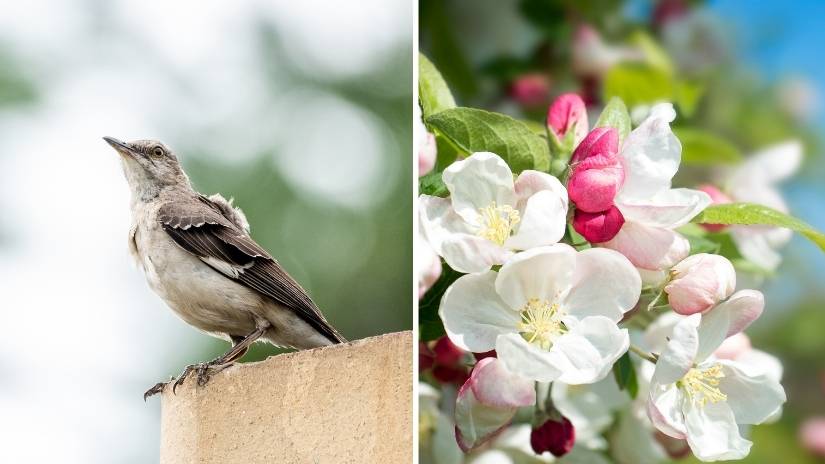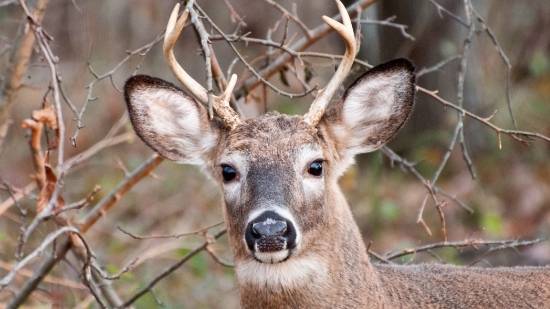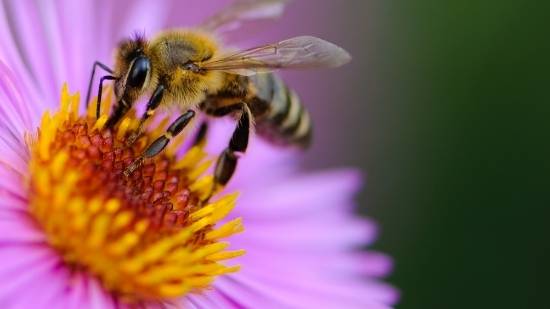Arkansas first began to adopt its own official state symbols in 1901. Many more have been adopted since then, and a state symbol can come in the form of state animals, mammals, a state bird and flower, fruits, vegetables, amphibians, nicknames, state seals, and much more.
State symbols were adopted by states to best represent them and their historical roots, and past and present successes. Like all other states, there are many Arkansas state symbols that epitomize the state.

Arkansas State Symbols List
There are an incredible amount of Arkansas state symbols which creates an abundance of interesting facts, both from the past and present. We have shortlisted the most significant Arkansas state symbols below and further down the page you will find a comprehensive table displaying all the Arkansas symbols and the date they were officially enacted.
Arkansas State Bird and Flower
The mockingbird (Mimus polyglottos) was adopted as the Arkansas state bird in 1929. The famous mockingbird is also the state bird for four other states, Florida, Texas, Tennessee, and Mississippi. These birds are truly beautiful and can be found all across the United States, they are a silver/gray color and love to sing!
They are incredibly well-known for their singing abilities, singing up to 200 different songs, which usually include other bird songs, insect and amphibian noises, and even the noises of machinery! Today, there are over 45 million northern mockingbirds living in the wild.

The stunning apple blossom has been the official state flower of Arkansas since 1901. Back in the early days, Arkansas was a major apple-producing state and still hosts its famous Arkansas apple festival on an annual basis in the town of Lincoln! The Arkansas state bird and flower are perfect representatives of the state, past, and present.
Arkansas State Mammal
Unlike most other states, Arkansas does not have an official state animal, instead, the state has adopted a state mammal to represent the state instead. The incredibly beautiful and majestic white-tailed deer became the state mammal back in 1993. These awesome animals are known for their shyness, beauty, and immense power, being able to run up to 40 miles per hour, jump 10-foot fences, and swim at around 13 miles per hour!

Their tails wave from side to side as they run, which flashes white as a warning when danger is approaching and also to confuse their predators. When they are born, they are born with white spots for camouflage. Historically, Native Americans and European settlers both heavily relied on these deer for their buckskin and their meat for food.
Arkansas State Seal
The famous Arkansas state seal was designed and created based on the territorial seal that was made by Samuel Calhoun Roane. The seal’s design was adjusted in 1836 when Arkansas officially became a U.S. state.

The famous great seal of the state of Arkansas requires certain elements to be present in any version of the state seal. The Arkansas State Code requires the following to be present:
- An eagle at the bottom, holding a scroll in its beak inscribed Regnat Populus, with a bundle of arrows in one claw and an olive branch in the other.
- A shield covering the breast of the eagle, engraved with a steamboat at the top, a beehive and plow in the middle, and a sheaf of wheat at the bottom.
- The Goddess of Liberty is located at the tip, holding a wreath in her right hand, a pole in her left hand, surmounted by a liberty cap, and surrounded by a circle of stars outside of which is a circle of rays.
- A figure of an angel on the left, inscribed “Mercy;” and a sword on the right hand, inscribed “Justice” and surrounded with the words “Seal of the State of Arkansas.”.
Arkansas State Insect
Honeybees are not only a popular insect in Arkansas, but there are a total of 17 states that use them as their official state insect! This is due to the significant role honeybees have played in agriculture and the nation’s ecosystem. It was during the year 1973 when the honeybee became the Arkansas state insect.

Arkansas State Tree
The pine tree became the official Arkansas state tree back in 1939, paying homage to the state’s pine timber resources and reforestation efforts that have been taking place over the past several decades. Arkansas is home to four native pine species, shortleaf pine, loblolly pine, longleaf pine, and slash pines, with the most commonly found being loblolly and shortleaf pines.

All Arkansas State Symbols (Table)
Now that we have taken a look at some of the more popular and notable state symbols that are associated with the state of Arkansas, it makes sense to showcase all the Arkansas state symbols that are best used to represent the state’s history and present achievements and moments. Here is the complete list of symbols:
| Type Of Symbol | State Symbol | Year |
|---|---|---|
| Arkansas State American folk dance | Square Dance | 1991 |
| Arkansas State Anthem | "Arkansas," words and music by Mrs. Eva Ware Barnett | 1987 |
| Arkansas State Beverage | Milk | 1985 |
| Arkansas State Bird | Mockingbird (Mimus polyglottos) | 1929 |
| Arkansas State Butterfly | Diana Fritillary Butterfly (Speyeria diana) | 2007 |
| Arkansas State Creed | The Arkansas Creed | 1972 |
| Arkansas State Flag | State and Civil Flag | 1913 |
| Arkansas State Floral emblem | Apple Blossom (Pyrus malus) | 1901 |
| Arkansas State Fruit | South Arkansas Vine Ripe Pink Tomato | 1987 |
| Arkansas State Gem | Diamond | 1967 |
| Arkansas State Grain | Rice | 2007 |
| Arkansas State Grape | Cynthiana grape (Vitis aestivalis) | 2009 |
| Arkansas State Great seal | Great State Seal of Arkansas | 1864 |
| Arkansas State Historic cooking vessel | Dutch Oven | 2001 |
| Arkansas State Insect | Honeybee (Apis mellifera) | 1973 |
| Arkansas State Language | English | 1987 |
| Arkansas State Mammal | White-tail deer (Odocoileus virginianus) | 1993 |
| Arkansas State Mineral | Quartz crystal | 1967 |
| Arkansas State Musical instrument | Fiddle | 1985 |
| Arkansas State Rock | Bauxite | 1967 |
| Arkansas State Soil | Stuttgart Soil Series | 1997 |
| Arkansas State Tree | Pine Tree (Genus Pinus L.) | 1939 |
| Arkansas State Vegetable | South Arkansas Vine Ripe Pink Tomato | 1987 |


